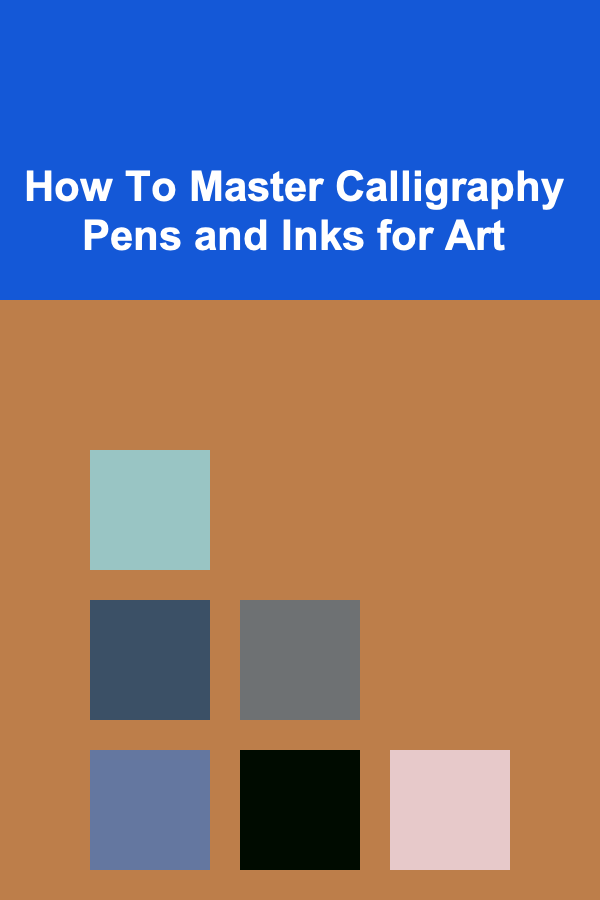
How To Master Calligraphy Pens and Inks for Art
ebook include PDF & Audio bundle (Micro Guide)
$12.99$7.99
Limited Time Offer! Order within the next:

Calligraphy is one of the oldest and most revered forms of artistic expression. Its roots stretch across centuries, with various cultures around the world developing their unique styles and techniques. Whether you're a beginner looking to explore this art form or an experienced artist wanting to refine your skills, mastering calligraphy pens and inks is essential for creating breathtaking pieces.
This guide will delve deep into the various aspects of mastering calligraphy pens and inks. From understanding the different types of pens and inks to tips for practice, this article will provide you with the knowledge needed to elevate your calligraphy art to the next level.
Understanding Calligraphy Pens
A calligraphy pen is more than just a tool---it is the extension of your hand that brings your creativity to life on paper. The choice of pen will affect your strokes, letterforms, and overall design. There are several types of calligraphy pens, each suited for different styles and techniques. Below is a detailed breakdown of the most popular calligraphy pens used by artists today.
1.1. Fountain Pens
Fountain pens are a classic choice for calligraphy due to their versatility and smooth flow. They are available in various nib types, ranging from fine to broad. For calligraphy, broad nibs are most commonly used, as they allow for thick downstrokes and thin upstrokes, creating the characteristic contrasts in calligraphy lettering.
Key Features of Fountain Pens:
- Nib Flexibility: Some fountain pens have flexible nibs, which allow for greater variation in stroke width, making them ideal for calligraphy.
- Ink Flow Control: Fountain pens provide consistent ink flow, ensuring even lines and precise strokes.
- Ease of Use: These pens are relatively easy to use and require minimal preparation compared to other calligraphy tools.
Fountain pens are perfect for beginners and seasoned calligraphers alike, offering a great balance of flexibility and control. However, they can be more expensive compared to other calligraphy pens, and regular maintenance, such as refilling ink and cleaning the nib, is necessary.
1.2. Dip Pens
Dip pens are the traditional choice for calligraphy and are highly favored by professional calligraphers due to their range of nibs and their ability to produce varied stroke widths. A dip pen requires you to dip the nib into ink before each stroke, offering a high level of control and precision.
Key Features of Dip Pens:
- Customizable Nibs: Dip pens come with interchangeable nibs, ranging from fine to broad or even specialized nibs such as oblique or flex nibs.
- Ink Dipping: Because dip pens require regular dipping into ink, they allow for a high degree of control over ink flow and coverage.
- Wide Range of Techniques: Dip pens enable a variety of techniques, including thick and thin lines, flourishes, and ornate letterforms.
Dip pens may take a little getting used to due to the need for regular dipping and their sensitivity to ink flow. However, their customizability makes them a favorite among advanced calligraphers.
1.3. Brush Pens
Brush pens are modern tools that combine the ease of a pen with the flexibility of a brush. These pens are commonly used for brush lettering and calligraphy, providing an artistic, flowing quality to your work.
Key Features of Brush Pens:
- Brush Tip: The flexible bristle tip allows for dynamic strokes, from fine to thick, depending on the pressure applied.
- Ink Flow: Brush pens typically come pre-filled with ink, offering convenience and ease of use.
- Variety of Tips: Some brush pens feature felt tips, while others have true brush tips made from bristles, giving you a range of effects.
Brush pens are perfect for beginners who want to explore calligraphy in a more fluid and expressive manner. They are widely used for modern calligraphy, and their versatility makes them a valuable addition to any calligrapher's toolkit.
1.4. Glass Pens
Glass pens are a beautiful and unique choice for calligraphy. Their nibs are made of glass and often feature intricate, artistic designs. Glass pens can be used with traditional calligraphy inks and offer a distinct aesthetic.
Key Features of Glass Pens:
- Elegant Design: The design of glass pens is often intricate and visually striking, making them a work of art in themselves.
- Smooth Ink Flow: Glass pens provide a smooth, consistent ink flow, though they may not have the same flexibility as other nibs.
- Limited Nib Flexibility: Unlike fountain and dip pens, glass pens generally lack the flexibility needed for varied strokes.
Glass pens are often more decorative than functional and are favored by artists for their aesthetic value as much as their calligraphy capabilities.
Choosing the Right Ink for Calligraphy
Inking your calligraphy pen is just as important as selecting the right pen. The ink you use affects the smoothness, color, and permanence of your strokes. Calligraphy inks come in many different types, each with its own characteristics.
2.1. Traditional Calligraphy Ink
Traditional calligraphy inks are usually made from a blend of pigments, water, and other chemicals to give them a smooth and rich consistency. These inks are ideal for use with dip pens and fountain pens.
Key Features of Traditional Calligraphy Inks:
- Rich Pigment: These inks provide deep, saturated colors that stand out on paper.
- Smooth Flow: Traditional calligraphy inks are formulated to flow smoothly, reducing blotching or unevenness.
- Variety of Colors: You can find traditional inks in various colors, including black, blue, red, gold, and more.
Traditional inks are a solid choice for most calligraphic applications, particularly for those who value precision and consistent color. They also dry relatively quickly and are ideal for detailed, intricate lettering.
2.2. India Ink
India ink is one of the oldest and most popular types of ink used in calligraphy. It is made from carbon black, water, and a binder. India ink is known for its deep black color and is often used in fine art and lettering.
Key Features of India Ink:
- Vibrant Black: India ink offers a rich, dark black color, making it ideal for contrast in calligraphy.
- Thick Consistency: It is thicker than many other types of ink, which allows it to create bold strokes.
- Waterproof: India ink is waterproof once dried, making it a good choice for artwork that may need to withstand handling.
India ink is an excellent choice for those seeking a high-contrast, bold look in their calligraphy. However, it can sometimes be harder to clean from pens and nibs, so regular maintenance is necessary.
2.3. Pigment-Based Inks
Pigment-based inks use colorants suspended in a liquid solution. These inks are widely available in various colors and are often used for calligraphy when vibrant hues are desired.
Key Features of Pigment-Based Inks:
- Permanent: Pigment-based inks are more permanent and lightfast than dye-based inks, making them ideal for archival projects.
- Color Options: These inks come in a variety of colors and finishes, including metallic and pearlescent shades.
- Ideal for Mixed Media: Pigment-based inks are well-suited for use with watercolors, acrylics, and other mixed media art techniques.
Pigment-based inks are a great choice for artists who want to experiment with colors and textures in their calligraphy.
2.4. Modern Inks for Brush Pens
Brush pens come with specially formulated inks designed to work well with flexible brush tips. These inks are often dye-based and are available in a wide range of colors, including vibrant hues and metallics.
Key Features of Modern Inks:
- Fast-Drying: These inks dry quickly, preventing smudging during writing.
- Smooth Flow: Modern calligraphy inks are formulated to flow smoothly without clumping.
- Versatility: These inks are ideal for creating expressive brush lettering and artistic calligraphy designs.
Modern inks for brush pens provide a smooth and consistent experience for calligraphers, especially those working with brush pens or brush-like markers.
Mastering Calligraphy Techniques
Once you've selected the right pen and ink, the next step is mastering calligraphy techniques. Calligraphy is as much about technique as it is about creativity. The following tips will help you improve your skills and develop your own unique style.
3.1. Understanding Strokes
Calligraphy is built on a foundation of strokes. Each letterform is created through a combination of thin and thick lines, with the thickness being controlled by the pressure applied to the pen. The basic strokes are vertical lines, diagonal lines, curves, and loops.
Practice Tips:
- Start with Simple Strokes: Before jumping into full letters, practice individual strokes like upstrokes, downstrokes, and loops. These basic elements will form the basis for your calligraphy.
- Control Your Pressure: Applying pressure to the pen results in thicker downstrokes, while lighter pressure creates thinner upstrokes. Mastering pressure control is essential for elegant calligraphy.
3.2. Developing Letterforms
Once you've mastered individual strokes, it's time to start creating letterforms. Each letter in calligraphy consists of a combination of basic strokes. Some styles, such as Copperplate or Italic, have specific rules for how letters should be formed.
Practice Tips:
- Study Traditional Scripts: To develop your letterforms, study classic calligraphy styles. Understanding the structure of letters like "a", "e", and "o" will give you a better sense of proportion and flow.
- Write Slowly: Begin by writing slowly to focus on precision. As you gain confidence, you can gradually increase your speed.
3.3. Creating Flourishes and Embellishments
Flourishes are decorative elements that add a personal touch to your calligraphy. They can be used to enhance certain letters, connect words, or frame your writing.
Practice Tips:
- Use Curved Strokes: Flourishes often involve elongated, curved strokes. Practice drawing flowing, continuous curves.
- Balance: Flourishes should complement, not overpower, the letters. Ensure they are proportional and balanced within the overall composition.
Maintaining Your Tools
Proper maintenance of your pens and inks ensures that you can continue creating beautiful calligraphy for years to come.
4.1. Cleaning Calligraphy Pens
Whether you use fountain pens, dip pens, or brush pens, cleaning your tools is essential to keep them in good condition and to prevent ink from clogging the nibs. For fountain pens, clean the nib regularly by flushing it with water. Dip pens should be cleaned after each use to remove any residual ink that may harden or clog the nib.
4.2. Storing Inks and Pens
Inks should be stored in a cool, dry place, away from direct sunlight to maintain their quality. Make sure the caps of ink bottles are tightly sealed to prevent the ink from drying out. Pens should also be stored in a safe place where they won't be damaged or exposed to dirt.
Conclusion
Mastering calligraphy pens and inks for art is a journey that requires patience, practice, and attention to detail. By choosing the right tools, understanding the intricacies of strokes and letterforms, and developing your own style, you can elevate your calligraphy skills to new heights. With the proper techniques and a commitment to learning, you can create stunning works of art that will captivate and inspire others.

How to Bring the Outdoors Inside with Holiday Decorations
Read More
How to Build Trust with Potential Dropshipping Partners Using LinkedIn Content
Read More
How to Make Your Home Feel Warm and Inviting with Lighting
Read More
How to Save for Big Home Purchases in Your Budget
Read More
How to Use Video Editing Software to Make Money
Read More
Top Affordable Meal Delivery Services That Won't Break the Bank
Read MoreOther Products

How to Bring the Outdoors Inside with Holiday Decorations
Read More
How to Build Trust with Potential Dropshipping Partners Using LinkedIn Content
Read More
How to Make Your Home Feel Warm and Inviting with Lighting
Read More
How to Save for Big Home Purchases in Your Budget
Read More
How to Use Video Editing Software to Make Money
Read More